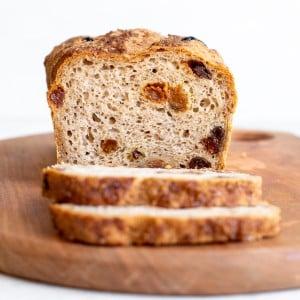This Gluten-Free Cinnamon Raisin Bread is soft, fluffy, and makes for the perfect slice of toast. With raisins and cinnamon all throughout, this will satisfy your sweet bread craving - and makes the best French toast & bread pudding ever. It's also vegan and top-8 allergen-friendly.
Meet the best gluten-free cinnamon raisin bread you will ever taste. Oh man, I am in love with this loaf. Light, fluffy, easy to make, not too sweet, full of fragrant cinnamon flavor, topped with cinnamon sugar, with raisins in every bite. This gluten-free cinnamon raisin bread became a quick favorite.
This cinnamon raisin bread is based on my oh-so-popular gluten-free bread recipe - which is a light and fluffy loaf that satisfies everyone I've ever shared it with, gluten-free or not. You could definitely make a version of this as well if you prefer!
You'll definitely want to check out all of my gluten-free bread recipes!
Which gluten-free flours should I use?
I don't use blends in my recipes, because they aren't as consistent as blending your own flours. This takes a bit more work and a few more ingredients on hand, but I think the effort is worth it to have consistent results! The flours we use for this recipe are tapioca flour, potato starch, brown rice flour and sorghum flour.
This combination balances the starches and the whole grain flours to make a bread that is both light and fluffy without being a pure white bread, since we get the added fiber and nutrients of the whole-grain flours.
If you would like to use a mix, I recommend this multi-flour blend from Vitacost. This blend uses very similar ingredients to the ones this recipe calls for, with no additives or gums.
Which yeast should I use for gluten-free bread?
For this cinnamon raisin bread recipe, we use active dry yeast. Make sure your yeast is gluten-free, as not all active dry yeasts are. I use this active dry yeast from Bob's Red Mill. This yeast requires activation with warm water and sugar - we use maple syrup in this case! After mixing with warm water and maple syrup, the yeast should bubble and foam up in about 5 to 10 minutes. If you don't see any activity, it's possible your yeast was old or the water was too hot or too cold (too hot will kill the yeast, too cold won't activate it).
I have not tested this recipe with instant yeast. So, I cannot say with certainty whether it would work or not.
What is psyllium husk?
Psyllium is a form of fiber that is derived from the husks of plantain seeds . It has a lot of health and digestive benefits, but it's the gelling, fiber-filled aspects of the plant that we're after here!
Psyllium husk is our gluten for this bread: it provides the binding properties and elasticity that make the dough be workable and allows us to knead it and shape it just like a traditional gluten dough. It gives the structure and support for the bread to rise, as well.
Substitutes for psyllium husk?
From my experiments: you need psyllium husk for good gluten-free sourdough bread. For my bread recipes, I wouldn't try to replace it. Psyllium helps make the dough workable, so it doesn't squish and stick all over the place. It's also what makes your bread chewy and stretchy.
NOTE: psyllium husk and psyllium husk powder are different. You want the full husk for this recipe and all of my other bread recipes. You can generally find it more easily anyways - I usually find it in the supplement area of most grocery stores. The powder is much more absorbent and I have not tried it in my tests, but I've seen others mention that you can use 75% of the amount called for in psyllium powder - so for this recipe we use 20g psyllium husk, if you have powder, you'd want to use 15g.
How to make Gluten-Free Cinnamon Raisin Bread
- Activate the yeast in warm water, with some maple syrup to help give it a boost.
- Mix up the psyllium gel which acts as our gluten in this recipe and helps make the dough easy to work with.
- Combine all the flours and dry ingredients in a mixing bowl, then add in the activated yeast and psyllium gel. Mix in a stand mixer or by hand until a dough forms with no dry spots.
- Mix in the raisins and fold in until completely incorporated.
- Let the dough rise for one hour for the first rise, and then knock the air out, shape, and place in your loaf pan or banneton for the second rise.
- Score and bake the bread until golden brown and delicious! If you'd like, you can coat the bread in cinnamon sugar before baking for a sweet topping.
- Cool completely before cutting into it - this will help prevent the bread from getting gummy! It's definitely the hardest part.
Want more delicious gluten-free bread?

